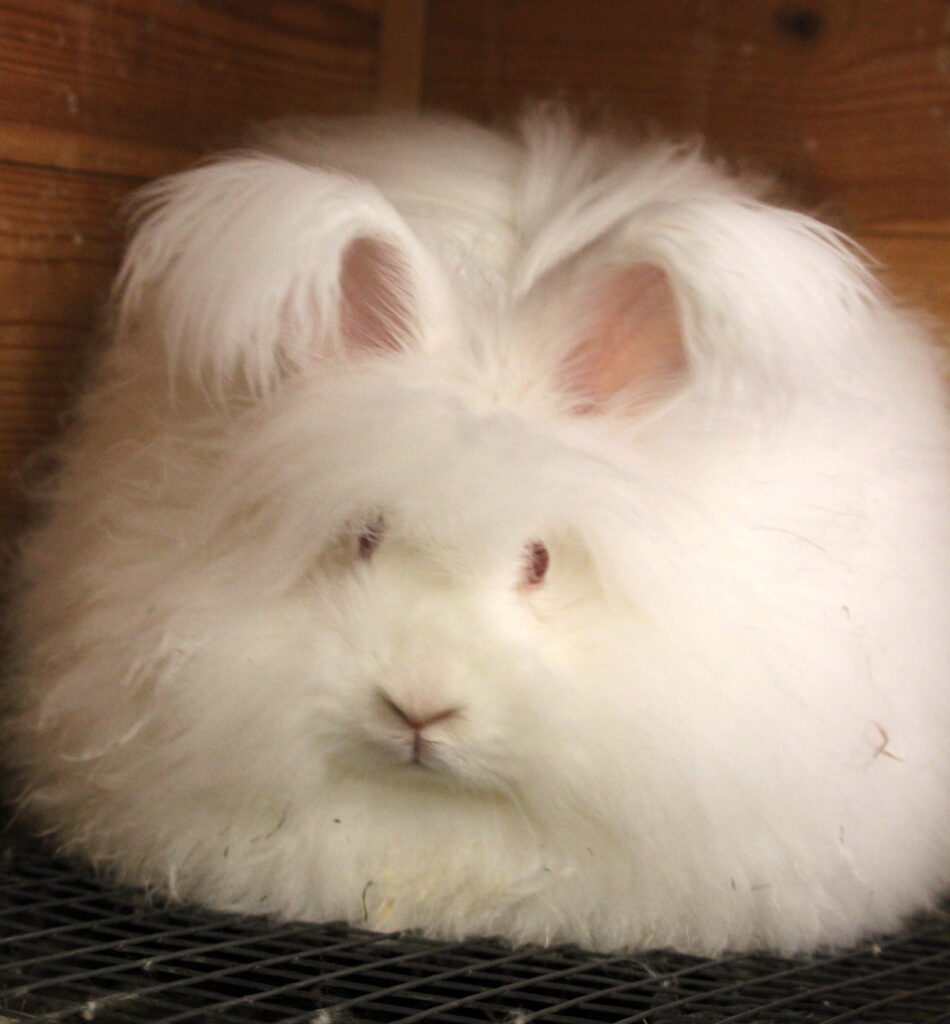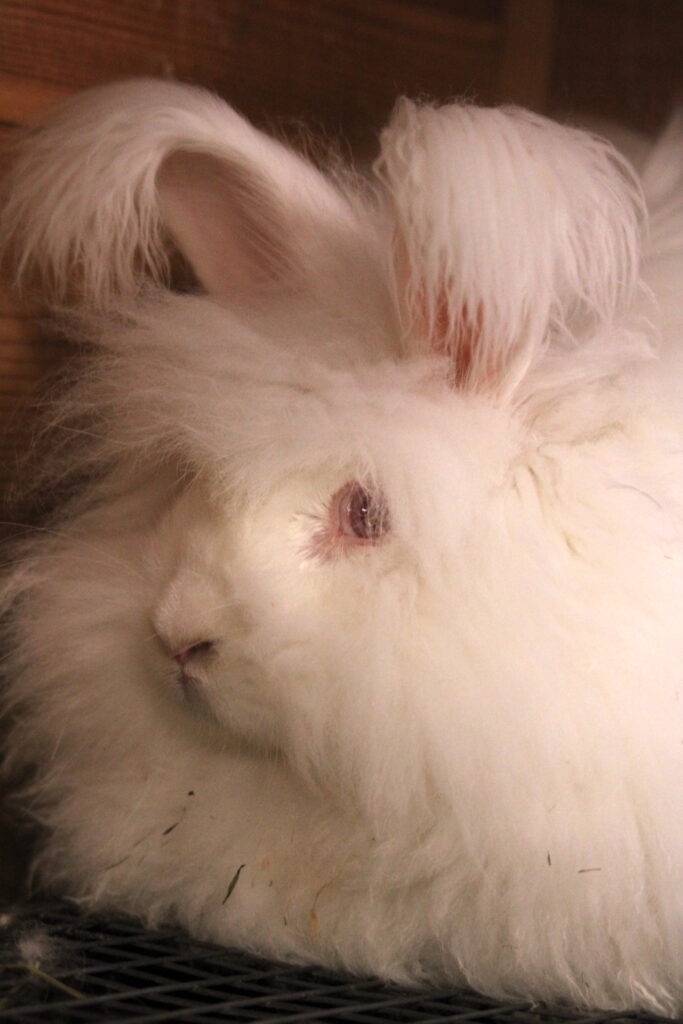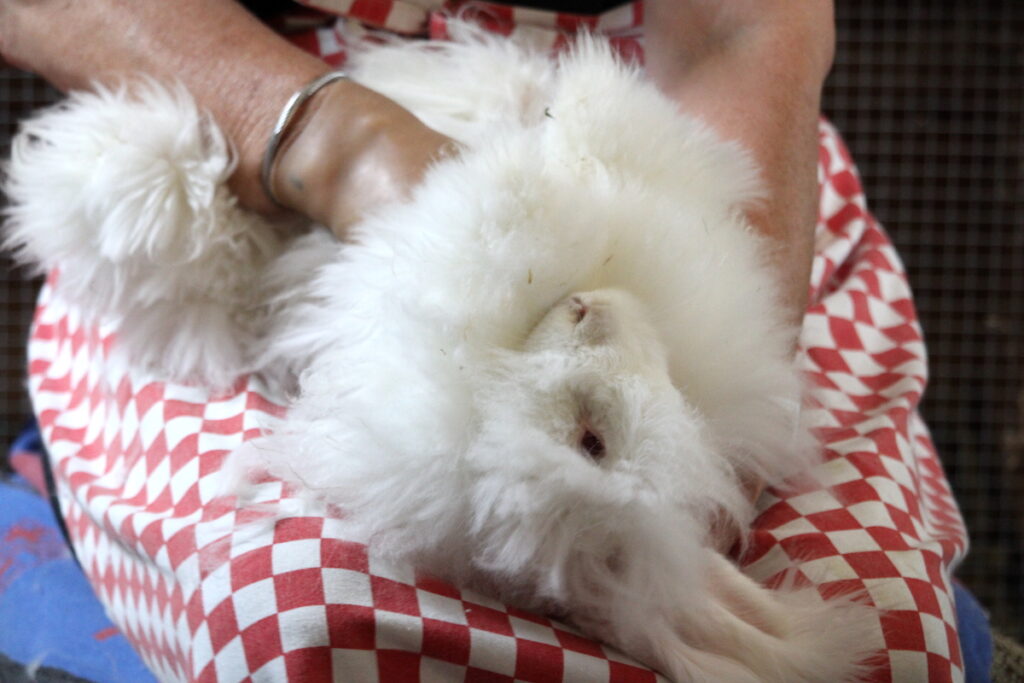
Most Angora rabbit owners clip their rabbit with hairdressing scissors, with the rabbit sat quietly on their knees. Most will sit calmly throughout the process occasionally wriggling and the process is not stressful for them. Here is a step by step of the process with photographs of clipping a White Angora rabbit and separating out the good quality wool for use for spinning from a show coat Angora rabbit.

One indication that your Angora rabbit needs clipping is runny eyes so watch out for this. Especially when the weather is warm and they have a full coat, it can lead to heat exhaustion and clipping is a quick way to relieve them of the extra warm layer.
Step 1: Getting comfortable
Step 2: Grooming pre-clipping
Make sure you have a comfortable chair and wearing an apron is always useful to stop you getting covered in wool during the process. Get your grooming tools and scissors for the clipping out and to hand within easy reach on a nearby table. Also get a box or bag to collect the cut wool in during the clipping process.
Once you are set then get your Angora rabbit out of the hutch and allow them to sit and relax on your lap before you start to clip the coat. During this initial time, it may be useful to do a little bit of grooming first to clean out any hay or debris from the coat as well as align the coat fibres.
Also during the clipping process you can stop at any time to resettle your Angora if they do start to wriggle and then start again. An experienced breeder usually takes around 20 to 30 minutes to clip an Angora rabbit but it doesn’t matter if it takes a bit longer if you are new to the process. The key is to make sure your rabbits welfare is paramount to the process so being relaxed and allowing yourself enough time helps.
Step 3: Start clipping the top coat
To start part the wool back and place the scissors close to the base of the wool but leaving a few millimetres from the skin. Once you have cut about two scissor lengths gather the cut wool and place it in your container.
Repeat the process across the top coat as this is the longest fibre length and useful to make wool products from later. Collect this separately to the wool from the underneath. It doesn’t matter if the remaining wool looks a bit uneven, you can trim the cut wool towards the end of the process to neaten it up if needed.
Step 4: Clipping the underneath coat
Once you have finished clipping off the top coat, you can then turn your Angora rabbit over to start clipping the underneath. One way is to place the rabbits ears between your knees and support their body on your lap. If they are less keen with their head being lower you can also turn them over with the head towards you gently holding the head and ears with one hand and clipping with the other.
This is the best method to reach the underside by turning the angora rabbit onto its back and working carefully with the scissors around the underneath of the body, legs, stomach, chin and around the tail.
The wool is clipped off as evenly as possible to avoid leaving one section longer than another. The underside wool is stored separate as it can be used for blending or felting, any dirty wool is usually not suitable for use but can be kept for nesting and labelled accordingly.
Step 5: Nail clipping
Great time to do a routine nail clipping and to check the condition of the feet, tail and underside of your Angora rabbit.
Step 6: Teeth check
This is an ideal opportunity to check the condition of the front teeth of your Angora rabbit during the clipping process.
Step 7: Post clipping
So once you have finished clipping, you can return your Angora rabbit to their cage. However remember to add additional bedding post clipping just in case they need more warmth in their hutch now that their wool is shorter.
You can clearly see the shape of the Angora rabbit once it has been clipped and they look a little naked but full of character still. She was quite happy throughout the process and once back in her cage she hopped around a bit now free from the dense woolly coat but then started eating the greens.
If you are unsure of any of the above though, please do not hesitate to get in contact with us at the National Angora Club either through the contact us page or if you are a member via our NAC Facebook page. We can provide advice and guidance on clipping your Angora rabbit and help put you in touch with other members in your area that can help you to learn to clip or offer a clipping service. Check out the next post showing a video of the clipping process described above.
















































